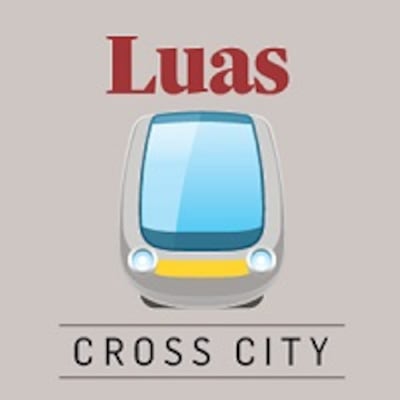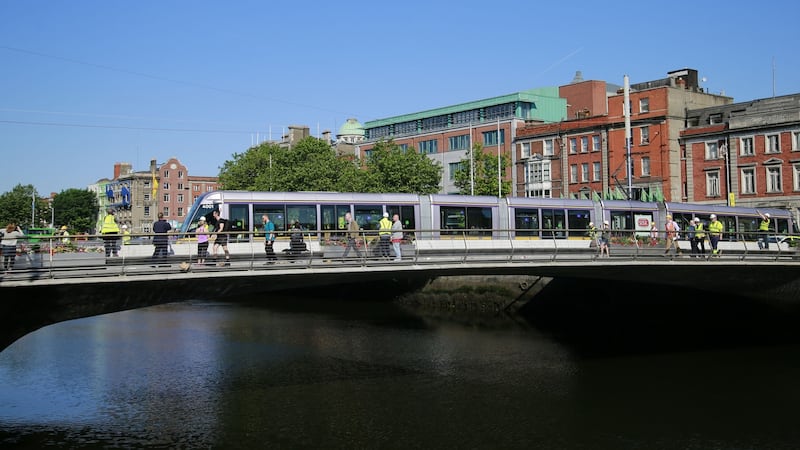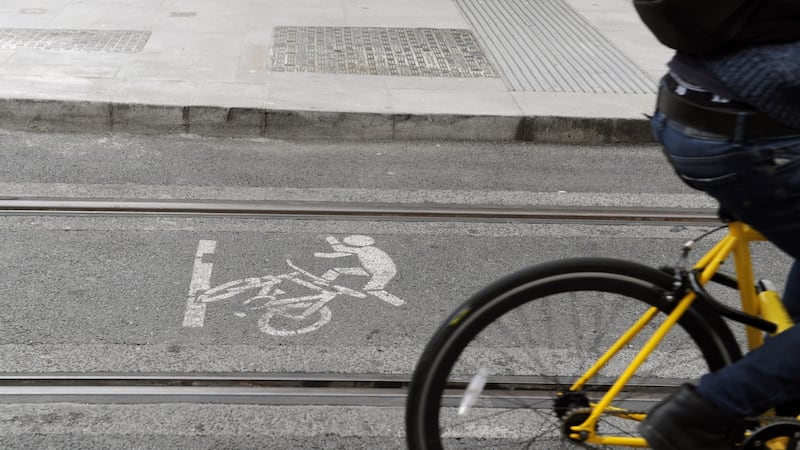Almost 70 years since tram tracks were ripped up from the Dublin city's streets, and more than 13 years since trams made their return to the capital, Luas Cross City – the "missing link" between the Luas Red and Green Lines – will start running next Saturday.

With 13 stops over its 5.9km length, the line will run from St Stephen’s Green, where the Green line from Cherrywood (Bride’s Glen) currently ends, and cut through the heart of the city down Dawson Street, around the front of Trinity College and through College Green. It will then head up Westmoreland Street and across O’Connell Bridge into O’Connell Street where it meets up with the Red Line, from Tallaght and Saggart to the Point.
Trams, which north of the river ventured only close to the quays until now, will strike out for the north side, continuing up O’Connell Street turning left into Parnell Street, right into Dominick Street, and across Constitution Hill into Broadstone, the first of its two stops serving the new DIT campus at Grangegorman.
From this point the line is “off-road” using the old Great Western Railway route to run to Phibsborough and Cabra, finally terminating at Broombridge where it connects with the Maynooth rail line.
On the way back to town, the line keeps the same alignment as far as the top of O’Connell Street but then rounds the back of the Parnell Monument and heads for Marlborough Street. It meets the Red line again at Abbey Street and then continues across the Rosie Hackett Bridge, specially built for the Luas in 2014.
It then runs up Hawkins Street at the side of the old Screen Cinema, and back in front of Trinity, to Nassau Street and Dawson Street and back to St Stephen’s Green, with the journey taking 27 minutes in each direction.
Catchier title
While the line has been given its own identity with the “Cross City” title, which is certainly far catchier than Luas BXD – its moniker when planning permission was first sought in 2010, it is actually an extension of the Green line. Passengers can if they choose go right the way from the developing suburb of Cherrywood, just beyond Sandyford, to Broombridge at the northern fringe of Cabra.
The most astonishing aspect of Luas Cross City is that, at €368 million, it is on budget, even slightly under its original €370 million price tag
Initially however, most trams won’t go as far as Broombridge but will stay in the city centre, looping back around the Parnell Monument and returning to St Stephen’s Green at three- to six-minute intervals. The run to Broombridge will be every 10-15 minutes, increasing to every four to six minutes in the first few months of next year.
The most astonishing aspect of Luas Cross City is that, at €368 million, it is on budget, even slightly under its original €370 million price tag, something rarely if ever seen with an Irish transport project.

Moreover, and although it might seem perverse to say, given the connecting line was given government sanction almost 13 years ago, the project has been delivered on time, with a late 2017 start date having been announced when the project secured planned permission in August 2012.
The next most astonishing thing about the new Luas, and certainly a less impressive feature, is that it had to be done at all. When first proposed in the mid-1990s the Luas had been designed as a continuous line from Dundrum to Tallaght through the city centre with a spur out to Ballymun. So why did we end up with two unconnected lines a 15-minute walk apart?
The urban myth is that the late Garret FitzGerald went out in the mid-1990s at the crack of dawn to measure the turn from Dawson Street to Nassau Street and determined, from an engineering point of view, it wouldn’t be possible for the tram to make the turn without ploughing into the side of Trinity College.
At the opening day of the Green Line in 2004, the former taoiseach said he had never done any such thing. He had however, opposed the running of the Luas line through the city centre, particularly Dawson Street and Nassau Street, because of the volumes of traffic in the city, which were only likely to increase given the burgeoning economy, and the likelihood that the trams would squeeze buses out of the city centre.
A vocal critic at the time, FitzGerald had favoured a cross-city rail link but one that ran underground.
Two-line solution
Whatever influence he and other commentators had, the decision not to run the tram through the city centre, and to choose the two-line solution, was made by the Fianna Fáil-Progressive Democrats coalition that came to power in 1997.
After a few forests’ worth of reports, a planning inquiry, a year of construction delays, and a budget increase from £250million (€317m) to €780m, at the end of June 2004 the Green line opened, followed by the Red Line three months later.
The very next year, the Government decided it had all been a terrible mistake and the lines would be joined up after all. In November 2005 the Fianna Fáil minister for transport Martin Cullen unveiled Transport 21, which recommended not only connecting the two Luas lines but also running a Metro underground, covering largely the same territory as the Luas in its city-centre section.
A proposed new Dart line would wrap around everything, connecting Connolly and Heuston underground through St Stephen’s Green.

Perhaps it was the strain of juggling all three, but, while a preferred route for the Luas link-up was identified two years later, no application to develop the line was made before the recession hit. It was 2010 before the Railway Procurement Agency applied to An Bord Pleanála for the railway order to build the line.
Just a month later, in the tragicomic saga that seemed to have engulfed the project, the Luas was dropped again – shoved out of the Government’s capital spending programme in favour of the Metro, although the planning process was allowed to continue so it could be picked up again at a later date.
It was the change of government that saved Luas BXD. Soon after Leo Varadkar took up the transport portfolio, he announced that only one of "the big three" transport projects – Metro North, Dart Underground and the Luas interconnector – would go ahead. Luas won, finally getting its sanction in November 2011, undoubtedly helped by its €370 million price tag.
Metro was projected to cost at least €3 billion, while Dart Underground was expected to cost €4 billion.
Icing on the cake
In August 2012 An Bord Pleanála issued the railway order and in November an updated business case for the line was approved. Work started in 2013 and four years later it’s a reality. The icing on the cake, is that €2 million has been shaved off the cost.
So all’s well that ends well? That remains to be seen. The risk of traffic chaos has by no means gone away, and while cars have been engineered out of certain areas, in others, the city will be reliant on the good sense and good behaviour of the private motorist, who could cause havoc at a number of points, particularly at O’Connell Bridge and Rosie Hackett Bridges if they block the junctions.
There’s also the issue of shared running with buses and Luas, and even taxis, on substantial sections of the line, including that tricky Dawson Street to College Green section. There are fears also of a rise in cycling accidents, due to the risk of wheels getting stuck in tracks.
All is speculation until the wheels start turning next Saturday, but it will be next year, when the longer, 55 metre trams hit the streets and the service starts running to a full schedule that the effect on Dublin city of linking the two lines will be fully realised.
This is the first in a series of articles on the Luas Cross City project and its expected impact on Dublin


















